The Side Plank…we love to hate it, but it is a must-do move if you want to build core stability and strength.
It’s a unilateral move that can correct imbalances and really works the abs, obliques, glutes, lats, and shoulders.
However, it is a tough move that many of us don’t do correctly, leaving us feeling like it is impossible to do or not as effective as it should be!
Because, like with all planks, it isn’t just about holding LONGER, but engaging the right muscles HARDER.
Let’s first take a look at the basic Side Plank and proper form. Then I’ll go over some great ways to modify the move to build up as well as some fun variations you can include in your workouts!
The Basic Side Plank Form:
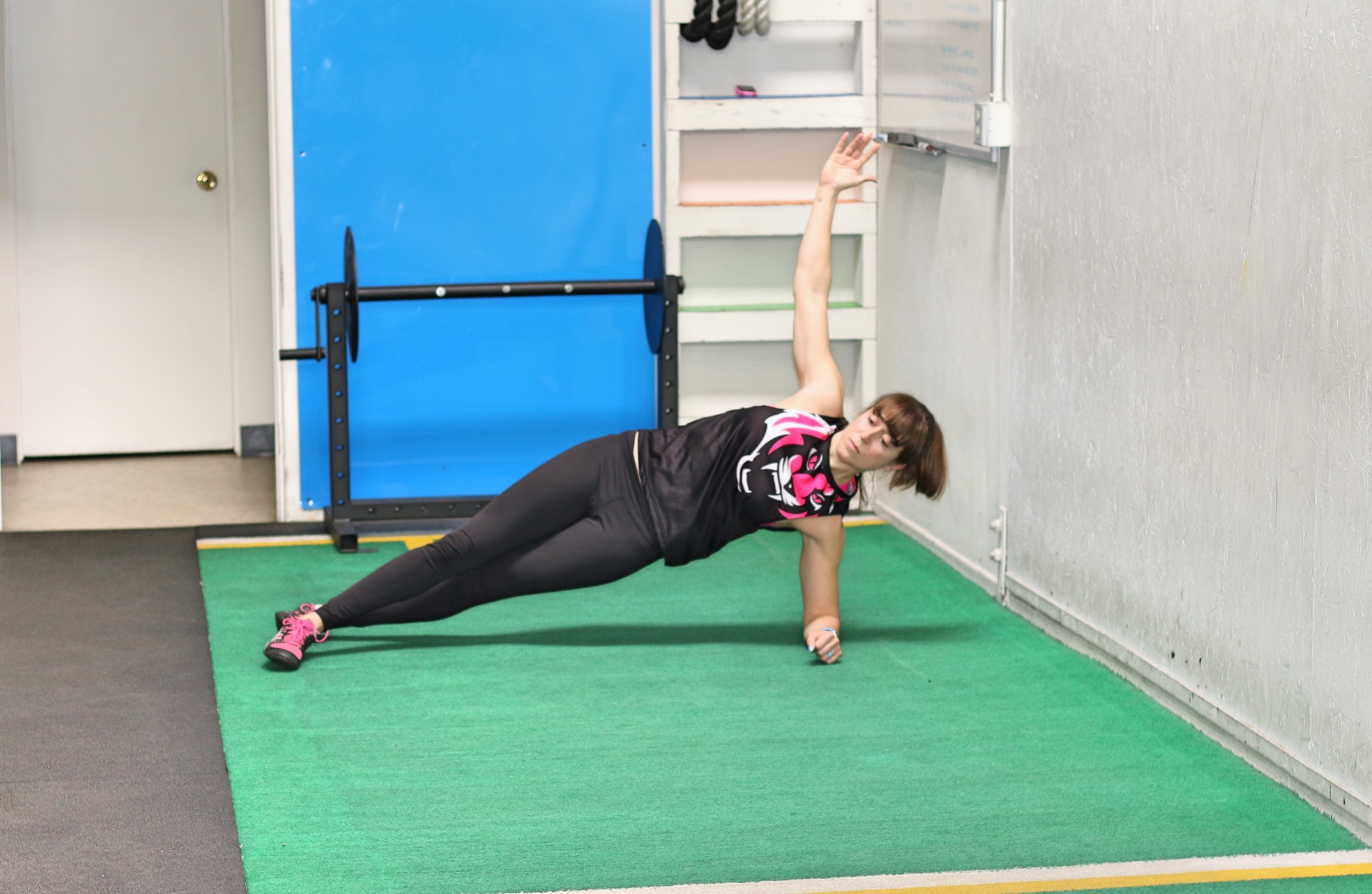
To do the Side Plank, start lying on your side with your top leg in front of your bottom leg, propped up on your elbow with your elbow under your shoulder. Rest on the inside of your front foot and outside of your back foot and then flex your feet as you lift up.
Lift your body up into a straight line, driving through your feet and elbow. Do not shrug your shoulder as you hold. Make sure that shoulder is aligned right over your elbow. Feel the side of your back under your armpit engage to support your shoulder as you lift up. You may even feel the muscles down the side of your rib cage.
Make sure too that you aren’t rotating toward the ground. Squeeze your butt and keep your body in a nice straight line as you lift up and hold.
Feel your glute and oblique working to lift that bottom hip up. You want to engage everything down the side of your body from your shoulder to your feet. Brace your abs, feeling everything engage.
Too often we just “rest” on the sides of our feet. But especially as we progress the plank, we need to create tension even through our lower leg. This not only helps us stay up and engage our glute, but it also prevents unneeded stress on our knees. So flex your feet to create tension all the way down.
Hold here and focus on what muscles are working. If you feel yourself compensating or your form breaking down, rest or regress. Do not try to focus on how long you hold, but instead on how well you are engaging everything!
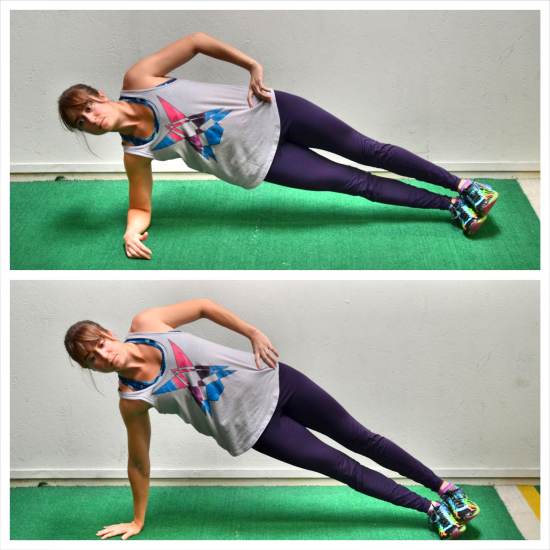
From here you can progress or advance the Side Plank by stacking your feet or even lifting your top leg. This can put more force on the spine so make sure your abs are working before progressing to this movement. You do not want your lower back getting overworked or bearing too much load. You can even do the Side Plank from your hand just make sure to keep your hand stacked under your shoulder to protect your shoulder and neck.
Beginners can also regress this move by doing it off an incline or by even dropping their bottom knee to the ground. The incline is a great way to learn to engage everything from your shoulders down to your feet.
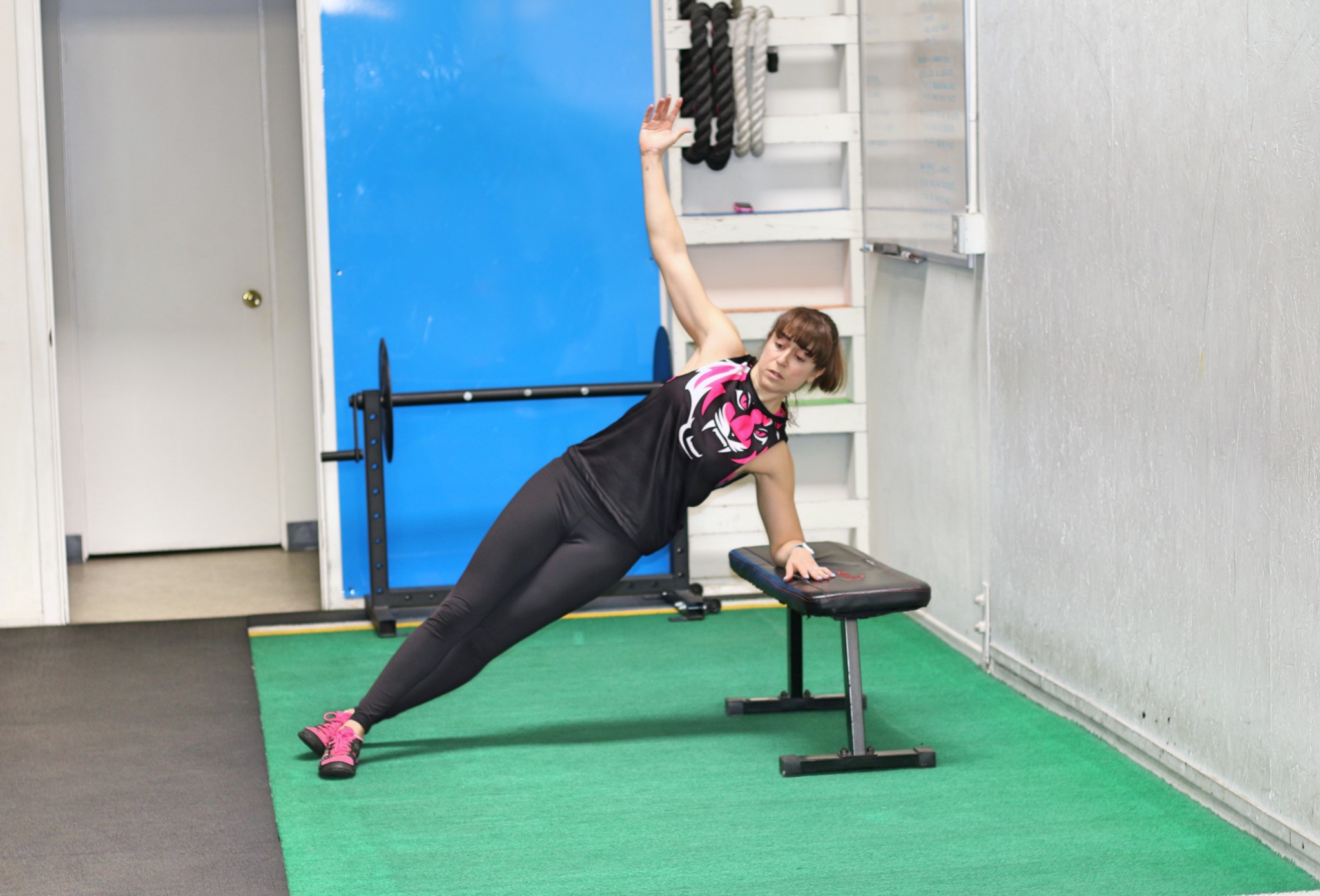
However, doing the side plank from your knee is also a great modification especially if you don’t have an appropriate incline near by.
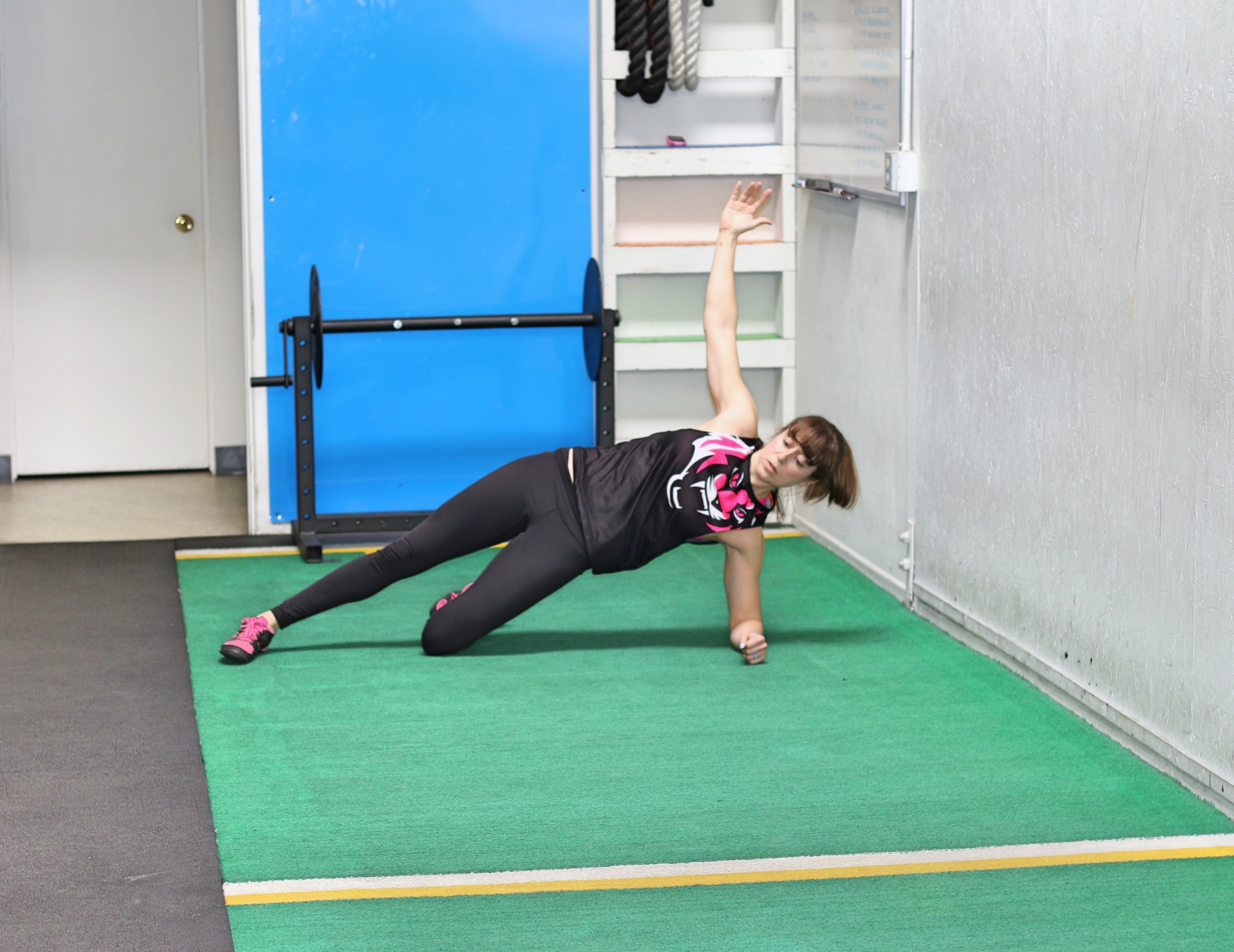
Best to do the version that allows you to do this move with proper form over compensating and letting your bottom hip drop or your chest rotate toward the ground.
Remember form is how you get the most out of the move and the right muscles working to get stronger!
So a quick summary of some important things to remember when working on your Side Planks…
Side Plank Quick Form Tips:
- Create tension all the way down your body, even flexing your feet to engage the outside of your lower leg.
- Stack your shoulder over your elbow and feel the side of your back engage. Do not let your elbow get above your shoulder toward your head so that your upper trap takes over.
- Do not let your bottom hip sag. Feel your oblique and glute on your bottom side lifting you up.
- Brace your abs and engage your glutes to extend your hips. Do not let your chest rotate toward the ground!
- THINK about the muscles working and engage harder instead of focusing on just holding longer!
After learning to do the Side Plank, and hold harder not just longer, you can mix things up and even target your core in different planes and from different angles with some of these fun variations!
5 Side Plank Variations:
These Side Plank variations are a great way to build core stability and strength and even work your core in multiple planes of motion!
Side Plank Hip Dips with Rotational Reach:
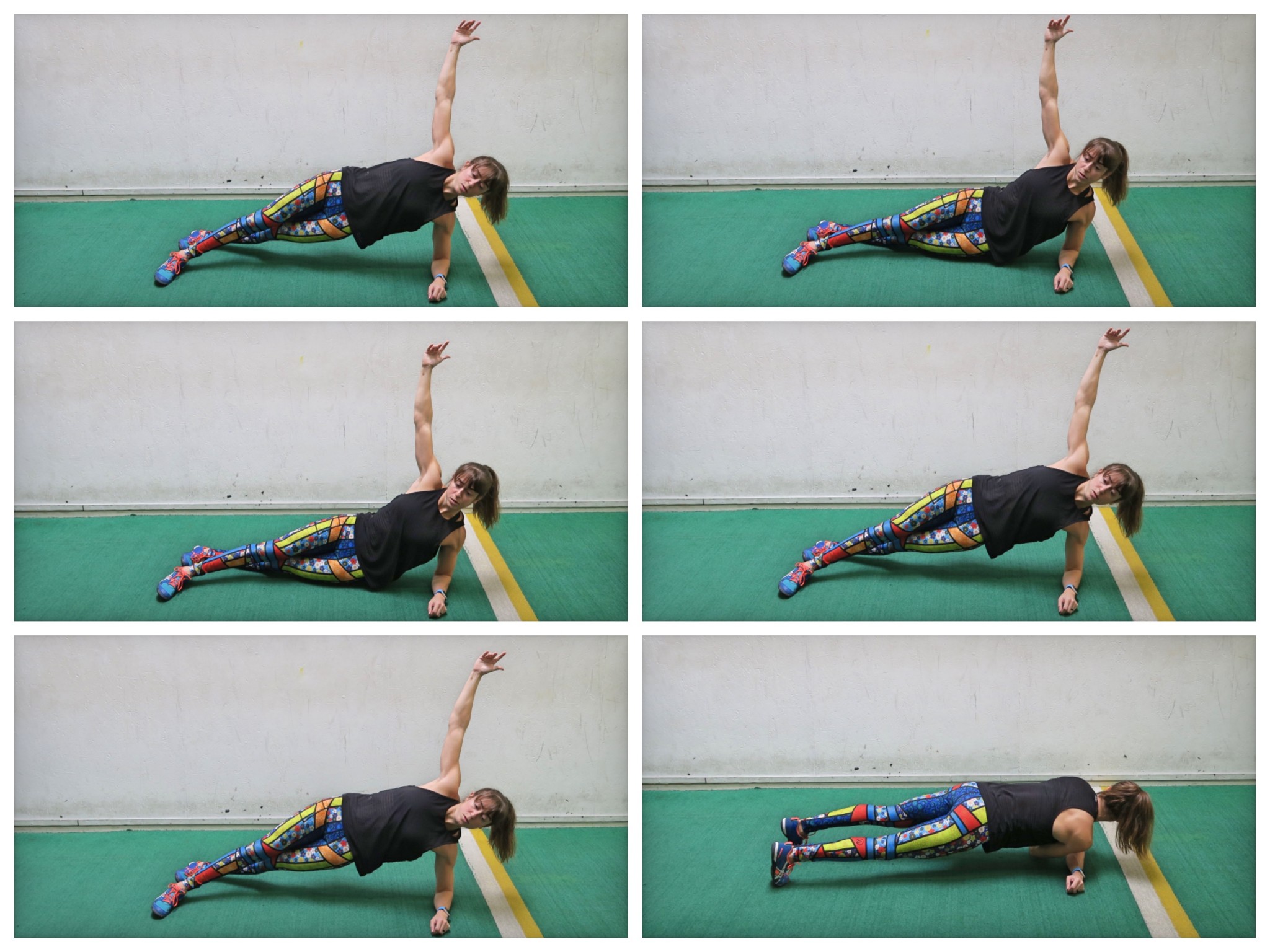
To do Side Plank Hip Dips with Rotational Reach, set up in a side plank from your forearm with your feet unstacked and your top leg in front of your bottom leg. Make sure your elbow is under your shoulder so you can engage your back to support your shoulder instead of just using your shoulder and even irritating your neck.
Then perform two hip dips, dropping your hip down to the ground before lifting back up into the side plank. Do not let your chest rotate toward the ground and really use that bottom side to lift back up as high as you can. Do not relax on the ground when you lower though.
After performing the two dips, reach your top hand down toward the ground and under your body as if reaching for the wall on the other side. As you reach under, pivot your feet as if moving into a front plank. Reach under then rotate back open into the side plank and repeat the hip dips.
Side Plank with Front and Back Toe Touches:
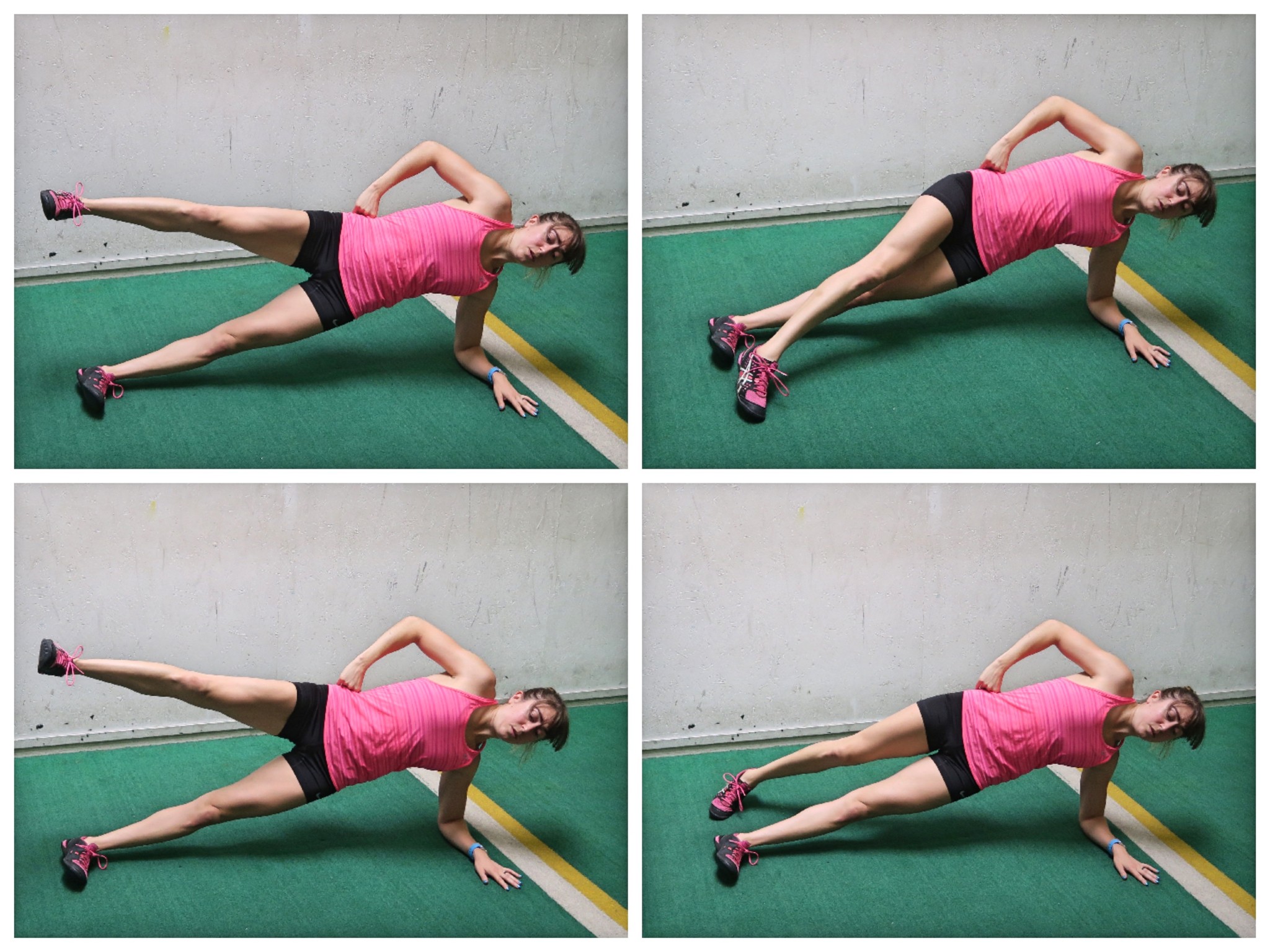
To do the Side Plank Front to Back Toe Touch, set up on your side and prop yourself up on your forearm with your elbow right below your shoulder. Your legs should be out straight and feet stacked. Then, driving through your forearm and the sides of your feet, lift your bottom hip up off the ground as high as possible while keeping your body in a nice straight line.
Squeeze your belly button in toward your spine and keep your glutes tight. Do not let your chest rotate forward toward the ground or your top hand touch the ground. Keep your top hand on your hip or reach it up toward the ceiling.
Then, holding the Side Plank, lift your top leg up toward the ceiling, then bring it forward to lower down and tap the ground in front of you. Raise it back up center then lower down to tap the ground behind you. Move slowly, lifting and lower with taps front and back.
Side Plank Adductor Lift:
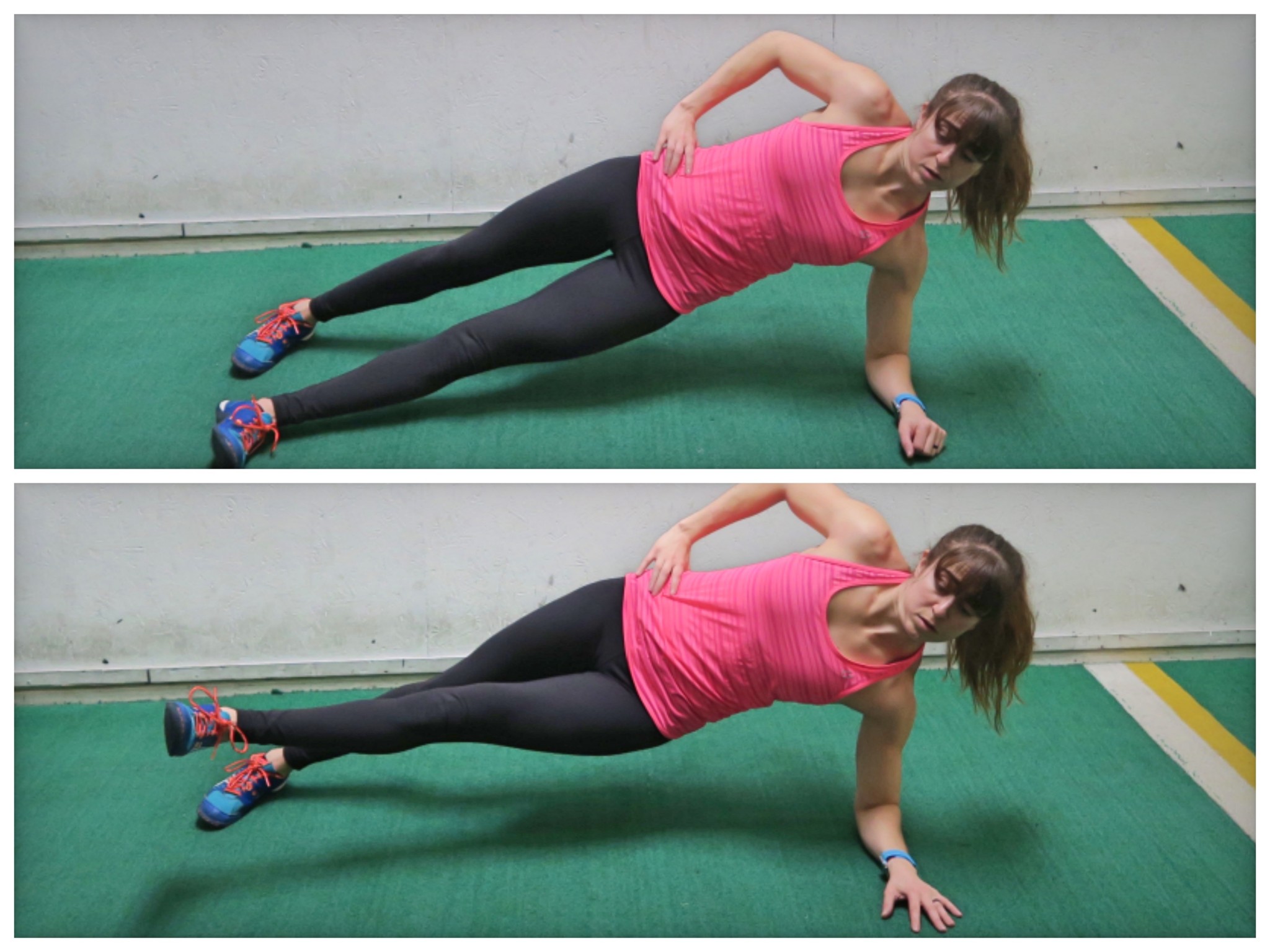
To do the Side Plank Adductor Raise, set up in a side plank from your forearm and feet. You will want you elbow to be under your shoulder and your feet unstacked with your bottom foot in front and even slightly angled forward. Lift up into the side plank position with your top hand on your hip and your chest not rotated toward the ground. Drive through the sides of your feet and flex your feet to engage even your lower leg.
Holding this position, lift and lower that bottom leg, raising it up a few inches then putting it back down at a controlled pace. Stay up in the side plank the entire time and don’t let your hips sag. Do not place your top hand down to assisted.
Side Plank Tree Pose:
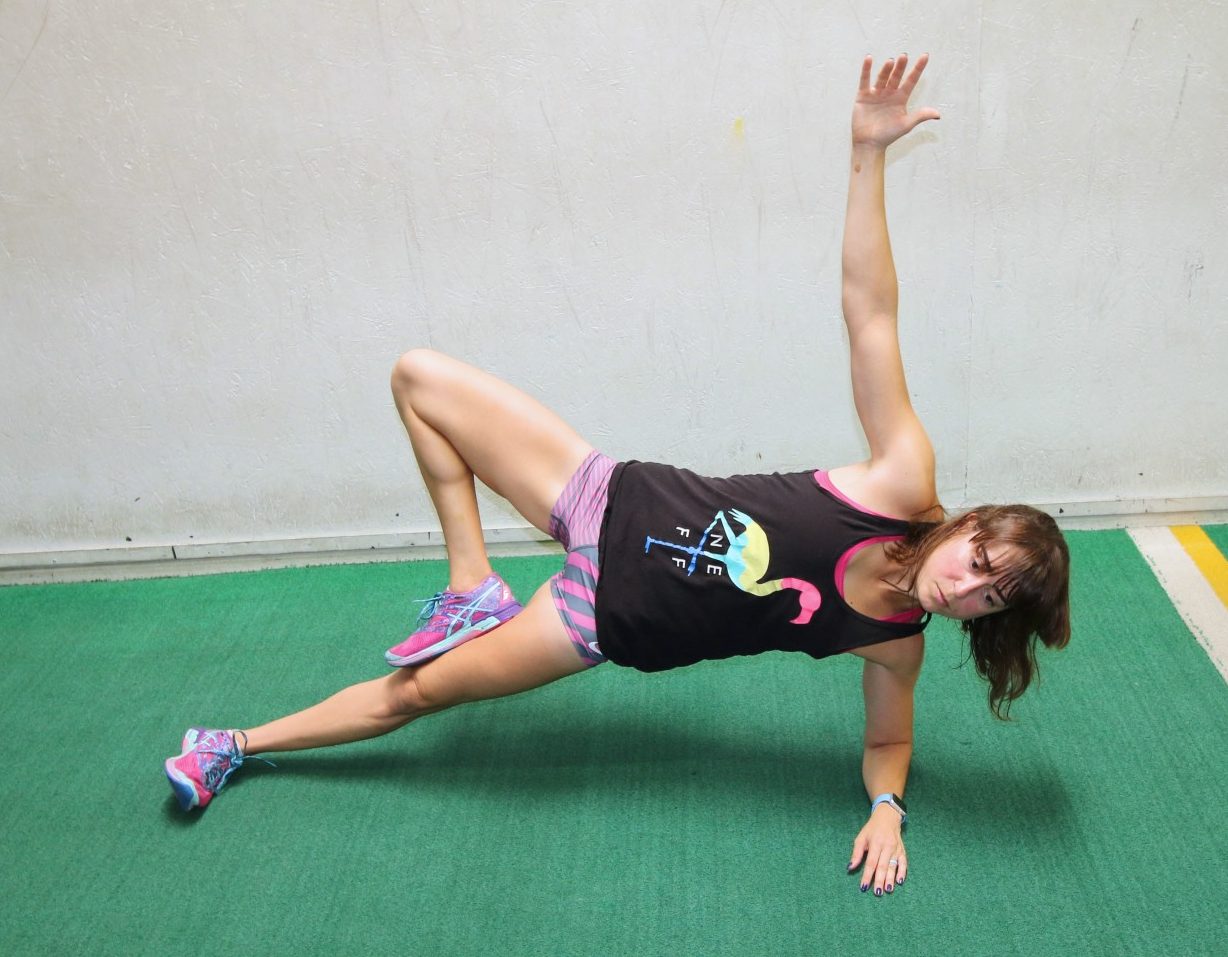
To do Side Plank Tree Pose, set up in a forearm side plank with your elbow under your shoulders and legs out straight and stacked. Flex your feet to create tension all the way down your leg.
Lift up into the side plank position and bend your top leg and place your foot flat on the inside of your upper thigh. Open your top knee up toward the ceiling and squeeze your butt as you drive your foot into your leg and keep your bottom hip up. Try not to rock open or rotate toward the ground.
Side Plank to Tabletop Toe Touch:
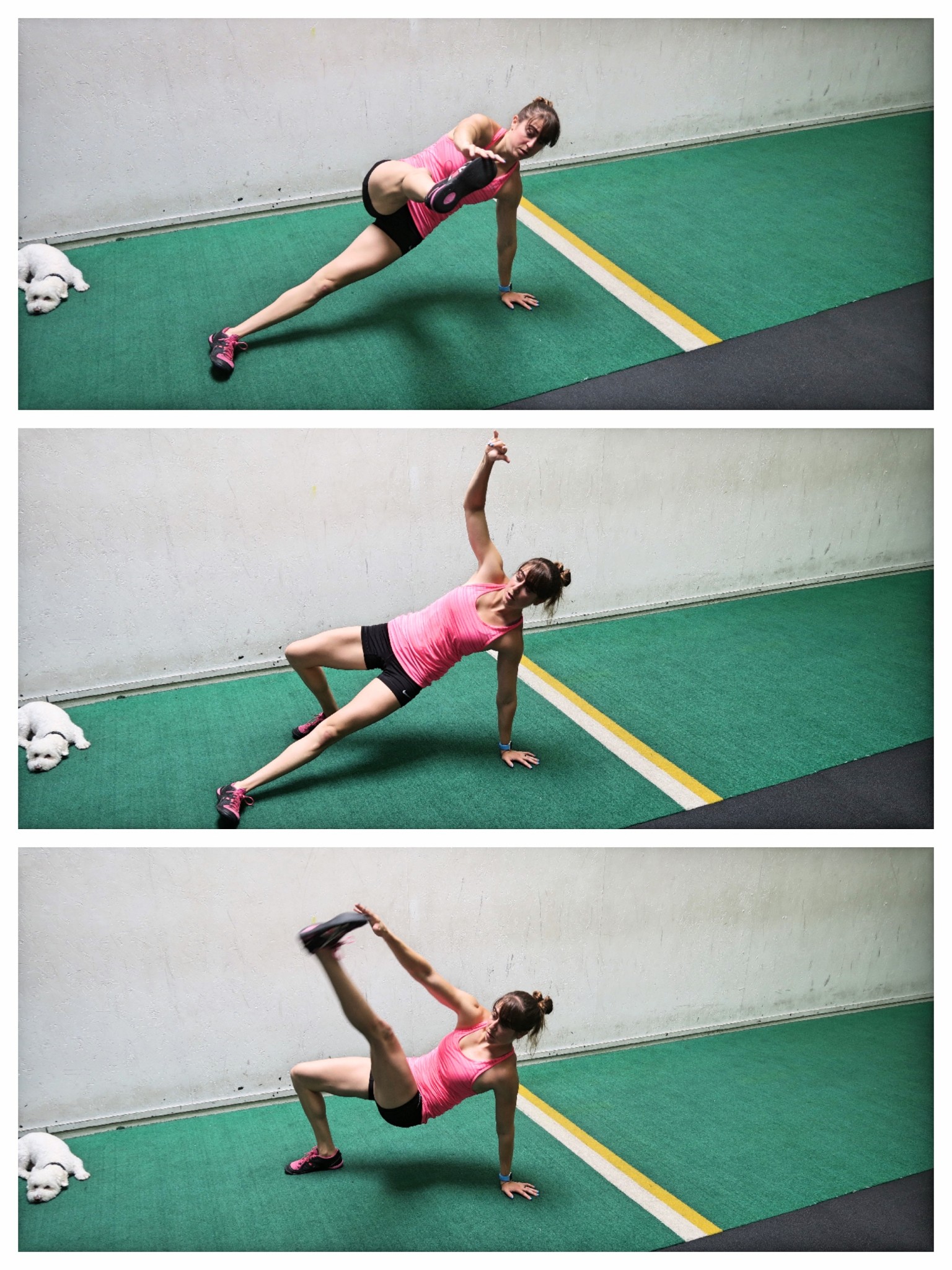
To do the Tabletop to Side Plank Kick, it may be easiest to set up first in the side plank from your hand. Stack your feet and engage your back to support your shoulder. You can reach your top hand overhead.
From the side plank position, lift your top leg up and kick it forward as you reach your raise hand to touch it. After touching your hand to your foot, straighten them back out.
And as you bring your arm back out and straighten your leg back out toward the side plank position, bend your knee, rotating your body open toward the ceiling as you put that foot on the ground behind. You will move into an almost turkish bridge position.
From here, raise your straight leg up (the one that was your bottom leg in the side plank) and reach the opposite hand to touch your toe. You are doing a kick from a tabletop position and reaching your hand to touch your toe.
Place the straight leg back down and move back into the side plank position and kick the top leg forward as you reach to touch your toe to repeat the move.
Love these Side Plank Variations and want even more fun ones? Ready for a strong, lean core that not only looks amazing but keeps you injury free? Learn more HERE!
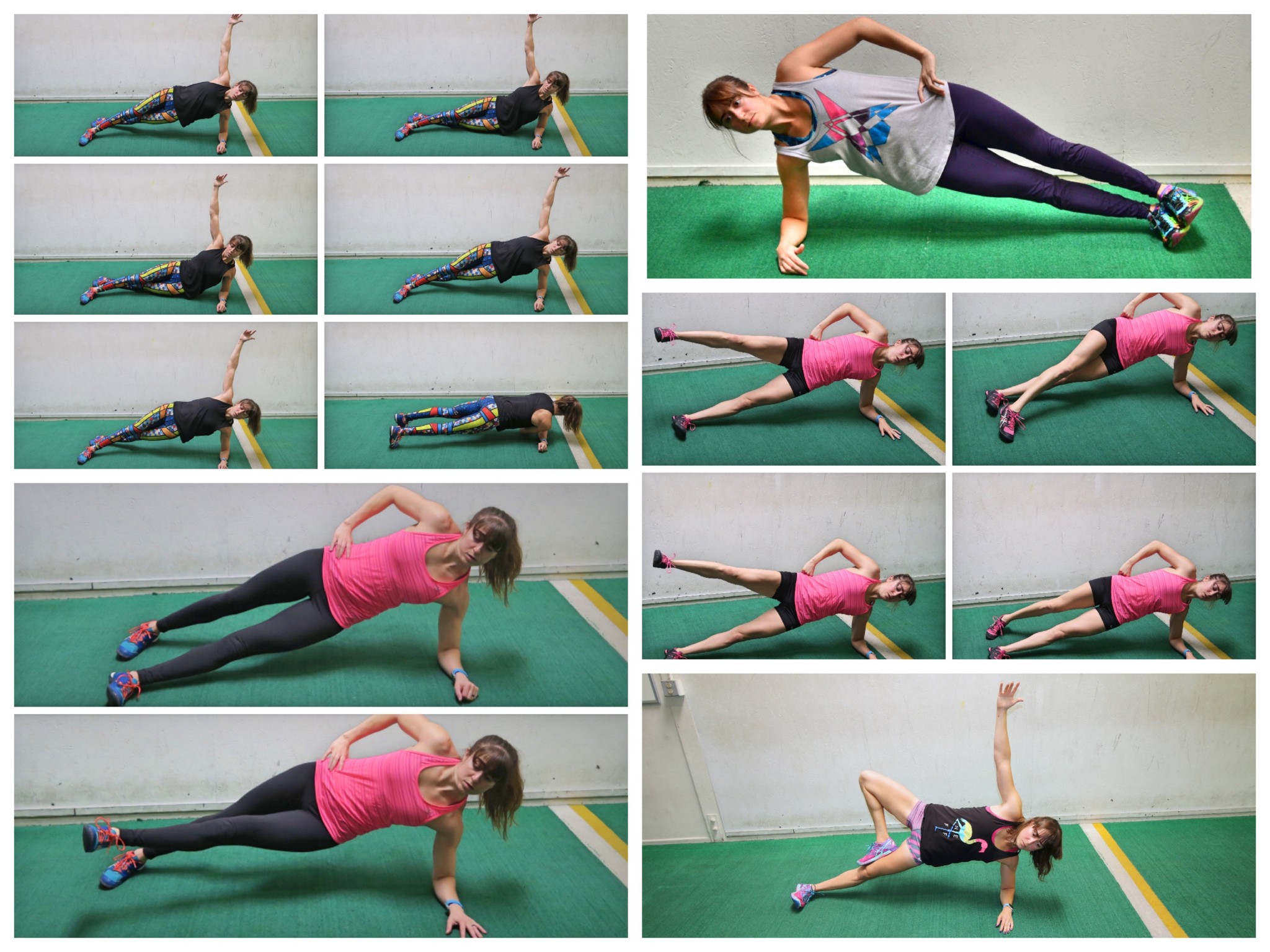



Hi Cori, thanks for another great article!
Any ideas/ tips on how to prevent the supporting ankle from collapsing (i.e. touching the floor) during a side plank?
Thanks!
I have folks with achey shoulders during the forearm side plank and their wrists are too weak to go into T-stand. I give them all the cues that have been suggested. Without bringing the bottom knee down, do you have another suggestion to help with their side plank? We don’t have a bench to increase incline.
The incline is definitely key. If you have a band that you can anchor up high and put around their waste that can also help lower the resistance.
I find that people with knee replacements say the side plank puts a lot of pressure on the knee as the angle pushes down toward the floor straining the joint. Flexing the feet helps a lot with that strain. Any other suggestions?
Flexing the feet and slowly building up, using the incline to start to reduce pressure as you get stronger 🙂
Bravo Cori! Awesome article!
Thank you very much!